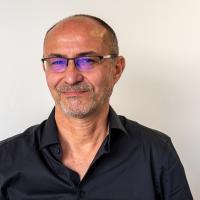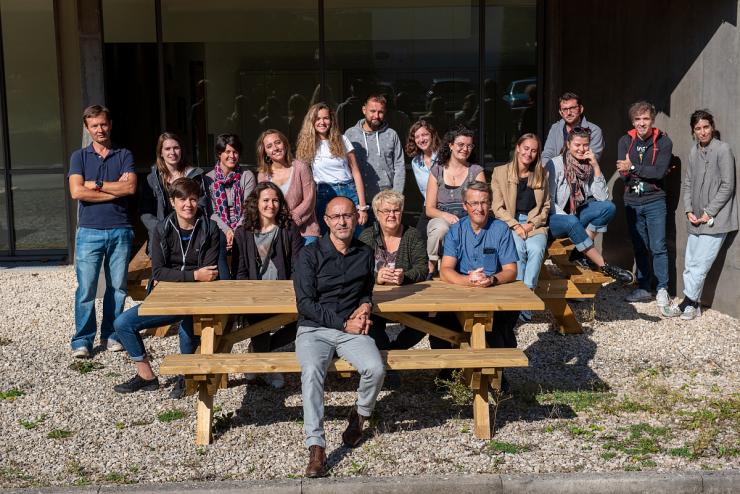
Agroecology Reading time 10 min
Laurent Philippot, pushing boundaries through excellence
Published on 29 November 2021
Today, Laurent is one of the 143 most-cited microbiology researchers in the world
Laurent Philippot is specialised in functional microbial ecology in order to manage agricultural inputs. More precisely, he explores how to leverage microbial processes involved in nitrogen cycling so that plants can take up as much nitrogen as possible (air is nearly 80% nitrogen) to meet their needs. The reason? To reduce greenhouse gas emissions related to nitrogen fertilisers in farming.
Laurent has worked in this field at the Joint Research Unit for Agroecology in Dijon since 1997. “I’ve been 1000% sure since I began my PhD thesis in the mid-nineties that this was what I wanted to do for the rest of my life,” he says with a smile. Today, Laurent is one of the 143 most-cited microbiology researchers in the world!
An internationally renowned specialist in soil microbial ecology
The 53-year-old researcher, who was born near Lyon, set up his “base camp” in Dijon in 1997. And yet, Laurent feels no particular attachment to any specific place. Before the pandemic, he spent around two weeks of every month abroad, splitting his time between his family in Sweden and travelling for work in Europe and around the world. And in the 2000s, he completed sabbatical years at universities in the US and Sweden. The paradox of this nomadic life is that he has spent his entire career – nearly a quarter century – at the INRAE Bourgogne-Franche-Comté research centre!
But the path to this point wasn’t always so clear cut. Originally, Laurent wanted to go into botanical research. So how did he end up in microbial ecology? While doing practical work at university, he was told that microbial ecology, not plant biology, was the field he had to study if he wanted to make plants grow. “And I believed it! I really got duped, but I don’t regret being pushed in that direction!” he laughs. “He is internationally renowned for his extensive contributions to the field of soil microbial ecology,” says Laurent’s former unit director, Philippe Lemanceau, who has known Laurent since his PhD days. The two men have collaborated on several large-scale research projects and co-authored many publications.
For Laurent, a researcher’s career is ultimately shaped by a series of encounters. One such encounter was with Fabrice Martin-Laurent, a microbial ecotoxicology researcher who arrived in Dijon around the same time as Laurent. The two men know each other well. “Laurent often understands faster than everyone else. That’s why he sometimes explains things very directly: Laurent is a leader who redefines boundaries,” says Fabrice, who became the director of the Joint Research Unit for Agroecology in 2021. “He is very courageous,” agrees Philippe Lemanceau.
A leader who pushes the limits
One particular episode from 2002 reflects this personality trait in Laurent and stands out in the minds of those who were at the centre at the time. Representatives from the Agronomy and Plant Health and Environment divisions came to Dijon to evaluate the Soil Microbiology Unit and the Research Laboratory on Soilborne Plant Pathogens. At the end of the visit, in a full but quiet conference room, the evaluators concluded the briefing with a question to the group from Laurent Bruckler, then head of the Agronomy Division: “So everything’s good, then?” To everyone’s surprise, Laurent Philippot stood up and said, “No, everything’s not good.”
Fabrice Martin-Laurent remembers it well. “He explained that the way research was being done at the time in the Soil Microbiology lab was stuck because of the siloed teams that had been in place for twenty years.” That day marked a major turning point in the laboratory’s trajectory – and in Laurent’s career.
The Institute’s management and the laboratory’s project leaders took his words seriously, and his desire to effect change was noted. Philippe Lemanceau and Laurent were tasked with working out how to merge their two teams, which resulted in the creation of the Joint Research Unit for Microbiology and Geochemistry of Soils in 2003.
“We were a generation of young researchers bringing new tools to the era of Pasteurian microbiology. Sharing among the teams and research topics the development and use of these tools such as soil DNA extraction or real-time PCR [polymerase chain reaction] analysis to study microorganisms seems obvious today, but people were sceptical at the time. We had to persuade everyone, but we finally got them to trust us,” says Laurent. This stage was one of the first roots that would lead to the creation of the Joint Research Unit for Agroecology “tree” some ten years later, notes Nathalie Munier-Jolain, centre president and former researcher at the unit.
More than 150 articles in international journals with a strong impact factor
“It was a challenge because we had to bring together researchers from quite disparate fields: agronomists, microbiologists, biochemists, geneticists, plant ecophysiologists,” says Nathalie, who took on more managerial responsibilities at the time.
As we said before, Laurent is not particularly long winded. “I don’t really try to embellish things. Stringing together long sentences, telling a story in which the scientific facts get diluted – that’s hard for me.” On the contrary, the researcher is much more at ease putting pen to paper, crafting his articles with a skilful hand. He has published more than 150 articles in international journals with a strong impact factor, such as Nature Reviews Microbiology, Nature Climate Change or The ISME Journal, a journal for which he served a stint as editor.
A respected mentor
“Laurent doesn’t like to express himself out loud. And yet, he agreed to go to China, the US and elsewhere to speak at conferences in front of several hundred people! He knew he had to accept the various requests for disseminating research results, rather than just publish it and call it a day,” says Fabrice Martin-Laurent. “He is always pushing his own limits,” says David Bru, a pillar of the team for more than 15 years. “He’s much more demanding with himself than he is with others.”
Philippe Lemanceau confirms his conscientiousness: “When he says something, you know it’s solid: structured, weighed, checked. That’s another reason why he’s so well known as a top researcher in his field.”
He wants to open the lab to researchers from other countries and promote it abroad
Those who work closely with him all agree that Laurent has always sought to conduct excellent research at the international level. “You can see it in how he recruits. He wants to open the lab to researchers from other countries and promote it abroad,” says David. “While Laurent has certainly driven science forward in Dijon, he’s first and foremost someone who cares about others, and especially his doctoral candidates.”
Since the beginning of his career at INRAE, Laurent has so many good memories that it’s hard for him to rank them. “There are a lot of little things that are all so important when they happen: doctoral candidates defending their theses, a paper that gets accepted, a project that receives funding… someone who wins an award!” he says with a chuckle.
WHAT'S NEXT
“To keep doing what I’m doing, but try to do it better!” By “do it better,” Laurent wants to focus his attention on mentoring to support his colleagues’ scientific advancement, regardless of where they are in their careers. He won’t say it himself, but his closest colleagues mention that he has already helped several colleagues change course within INRAE – including two from Dijon who have also won INRAE Awards! Another thing that’s important to him: to help promote gender equality in the lab.

THE INRAE AWARD?
He admits that the phone call from Philippe Mauguin to announce this award came as a surprise. “It was like being in a dream, the day it happened. It takes a while to sink in,” says Laurent. “Recognition”, “dedication”, “pride”: in typical style, Laurent prefers to express his feelings with impactful words. Clear, concise, precise.
Mini-CV
53 years old, married with 2 children
- Career
Since 2007: Research director, Agroecology Joint Research Unit (INRAE, Univ. Bourgogne, SupAgroDijon, CNRS), INRAE Bourgogne-Franche Comté research centre
2009-2010: Sabbatical year at SLU, Uppsala, Sweden to study the ecology of bacteria involved in the nitrogen cycle
2000-2001: Sabbatical year at Georgia Tech, Atlanta, US to study bacterial chemotaxis.
1997-2007: Research scientist, INRAE - Education
2006: Accreditation to supervise research (HDR), Université de Bourgogne
1997: PhD in Microbial Ecology, Université Claude Bernard Lyon 1
1993: Master in Biology, Université Claude Bernard, Lyon 1 - Awards and honours
2021: INRAE Scientific Breakthrough Award
2019: Award from the Chinese Academy of Sciences
Since 2018: Ranked among the most-cited researchers in the world (Clarivate Analytics) - Hobbies: Taking care of the plant biodiversity on his terrace
